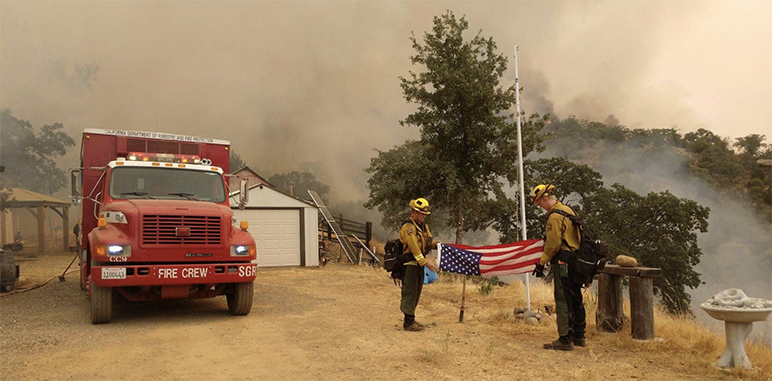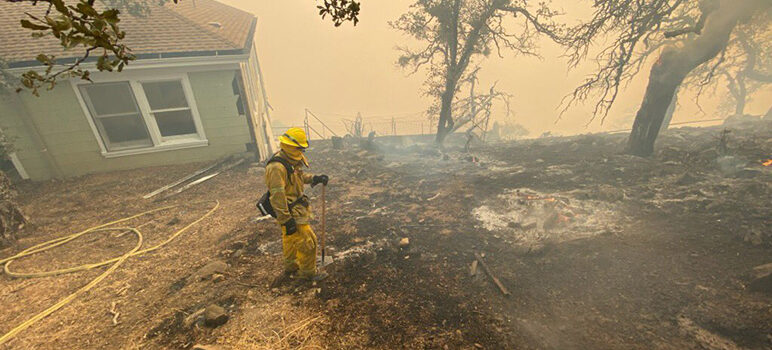Tens of thousands of evacuees. Scores of burned homes. Several injured. Five dead.
Lightning-sparked fires spawned by freak storms over the weekend have since consumed 500,000 acres in and around the Bay Area and show no sign of letting up.
In three major clusters, they darkened skies, forced thousands to flee, scorched Big Basin’s ancient redwoods and pushed California’s firefighting capacity to the brink.
The SCU Complex—which grew from a group of 20 fires in Santa Clara, Contra Costa, Alameda, Stanislaus and San Joaquin counties—exploded overnight by more than 40 percent to become the largest in California.
At 230,000 acres, the SCU Complex east of San Jose has officially surpassed its North Bay counterpart, the LNU fires in Sonoma and Napa counties. The fire extending south along Mt. Hamilton is now the the seventh largest ever recorded since Cal Fire began keeping track of such things in 1932.
Officials today reported just 10 percent containment for the SCU Complex, with five structures destroyed and four people hurt.
Cal Fire this morning pushed the boundary of evacuation zones for the SCU Complex away from San Jose city limits, as the fire spread south and inland.
“Continued high temperatures across the unit with warm and dry overnight conditions are expected for today,” Cal Fire wrote in a 7am update.
Officials say the fire will likely grow even faster in the dry heat of the afternoon, even with with more than 1,100 firefighters using four helicopters, 101 engines, 29 bulldozers and 33 water tenders to rein in the ravenous flames.
“Expect critical rates of spread when fuels, wind, and topography are in alignment and in increase in fire activity after [12pm],” the Cal Fire forecast went on to predict. “Today, crews will continue to scout for safe access points in order to construct fire line, protect structures and critical infrastructure.”
With wildfires threatening communications, transportation, gas lines, schools, parks, watersheds, the Lick Observatory and about 30,500 homes in Santa Clara County, FEMA today announced that it would chip in federal funds to combat the conflagration.

More than 1,100 firefighters are battling the SCU Complex today. (Photo via Cal Fire)
Cal Fire, which has never fought on so many battle lines at once, welcomed the help.
In the past 24 hours, California reportedly equipped some C-130 military planes as air tankers and added another 3,000 firefighters to Cal Fire’s ranks, bringing the total statewide to 10,000. Since Gov. Gavin Newsom on Wednesday called on the rest of the country for backup, other states have supplied hundreds more fire engines while National Guard troops jumped into the fray to staff hand crews and pilot helicopters.
Still, officials said it’s not nearly enough.
In a normal fire season, Cal Fire said it would have deployed about 2,000 personnel to quell the CZU Complex roaring through the Santa Cruz Mountains and up the Peninsula.
But normal seems a thing of the past.
With hundreds of hotspots throughout the region, the state could only manage to assign 1,000 firefighters to the 50,000-acre CZU inferno driving through thick bone-dry forests from the Santa Cruz coastline to the San Mateo County peninsula.
Five days after a treacherous mix of monsoonal moisture and triple-digit heat spawned electric storms that started 367 blazes, the trio of Northern California fire complexes remain almost entirely out of control. Today, Gov. Newsom announced that the number of fires has grown to 565—with most concentrated around the Bay Area.
This morning, Cal Fire reported zero containment for the CZU Complex in Santa Cruz and San Mateo counties and LNU burning nearly 220,000 acres in the North Bay.
Nightfall that typically brings more humidity has been extremely dry, leading some fires to double in size from dusk to dawn, Cal Fire officials explained. Meanwhile, erratic gusts are spreading embers that ignite still more fires.
While some evacuations eased up late Thursday in Vacaville and parts of northern San Jose, Cal Fire expanded them in counties threatened by the CZU and SCU clusters.
The latest evacuation orders impacting 17,500 people in the South Bay stretch 52 miles from Contra Costa County to the Salinas Valley. It’s an extraordinary expanse, reflecting the state’s caution after seeing so many fatalities in the past few fire seasons and witnessing the stunning ferocity of the one underway.

